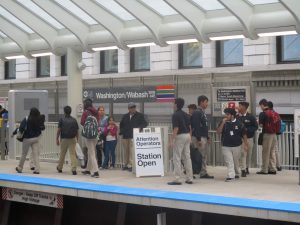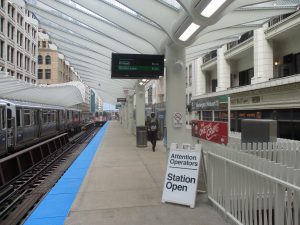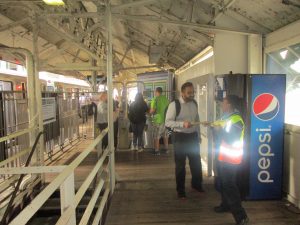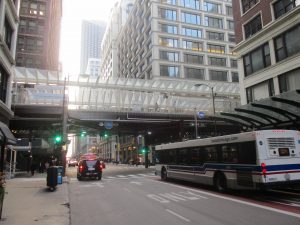New Loop ‘L’ station opens as old station closes
By Igor Studenkov For Chronicle Media — September 5, 2017
Noble charter school students prepare to board the ‘L’ trains at the recently opened Washington/Wabash ‘L’ station. (Photo by Igor Studenkov/for Chronicle Media)
The last week of summer saw a changing of the guard for Chicago ‘L’ system’s iconic elevated loop.
On Aug. 31, the Washington/Wabash ‘L’ station opened after two years of construction. And on the morning of Sept. 3, the nearby Randolph/Wabash station closed for good in preparation for demolition. It was the first new ‘L’ station to open since 2015, and the first station to open since 1997 that wasn’t built on the site of a previously demolished station.
The Washington/Wabash station was built to replace two stations — the Randolph/Lake station and the Madison/Wabash station. While the later was closed and demolished before the construction began, the former remained open until its replacement was built. City and transit officials touted the Washington/Wabash station as a modern facility that, unlike the two stations it is replacing, is accessible to people with disabilities — something echoed by the riders who spoke to the Chronicle.
Randolph/Wabash station originally opened on Nov. 8, 1896. It went through extensive retrofitting. The original station houses were removed, and a connection to the nearby Marshall Field’s department store was added. In the next few decades, that connection was removed, the station house at the east platform was replaced with a simpler structure and artwork from the nearby Gallery 37 was added.
Since the late 1980s, the Chicago Transit Authority has been working to pare down the number of Loop stations in order to speed up service and reduce operating and maintenance costs. In mid-1990s, it put the idea into practice on the west side of the elevated loop, replacing Madison/Wells and Randolph/Wells stations with Washington/Wells station.

Trains began stopping at Washington/Wabash ‘L’ station on the morning of August 31. (Photo by Igor Studenkov/for Chronicle Media)
While Madison/Wells station has been completely demolished, portions of Randolph/Wells platforms are used for storage to this day.
The changes to the east side of the loop took longer. The Madison/Wabash station was closed on March 16, 2015. As was the case on the other side of the loop, once it was demolished, the construction of the intermediate Washington/Wabash station began.
Like Washington/Wells station, the Washington/Wabash station was built between Washington and Madison streets. The north ends platforms Washington Street, while the south ends of the platforms stopped directly south of Madison/Wabash intersection, a little past what used to be the middle of Madison/Wabash station. Similarly to Washington/Wells station, it has two entrances are located between the two streets and two entrances closer to Washington Street. There are two stairs leading to Madison Street, but they are exit-only.
As with Madison/Wabash, the fare controls are located on the mezzanine level under the tracks. Riders can use that level to transfer between platforms, and unlike at Randolph/Lake, they won’t have to swipe their Ventra cards to do it.
The station represents a first for the east side of the elevated loop. Before Washington/Wabash opened, it was the only side that didn’t have any stations accessible to people with disabilities. The new station comes with elevators that allow riders to reach the mezzanine level and the platforms.
In another first for the elevated loop, it is the only station where the canopies cover the entire length of the platforms rather than just the middle section.

CTA employee hands out fliers alerting riders about the impending closing of Randolph/Wabash station at the station’s eastern platform. (Photo by Igor Studenkov/for Chronicle Media)
According to the project page on the CTA website, the station design incorporated a number of environmental sustainability features. All lighting is LED, the structural steel components were made of recycled materials and the HVAC systems use chlorofluorocarbon-free refrigerants. The page also points to the fact that the station comes with bike racks and, in another first for the system, full-fledged recycling bins instead of green paper recycling boxes.
Like the Randolph/Wabash station is replaced, the Washington/Wabash station is being billed as a transfer point to Millennium Station — the terminal for Metra Electric Line and the Northern Indiana Commuter Transportation District’s South Shore Line. However, while Randolph/Wabash station was only a block west of the Millennium Station main entrance, the new station is one block further south, so the connection is less direct.
While both Randolph/Wabash and Madison/Wabash stations could be used to reach Millennium Park, the Washington/Wabash station put a stronger emphasis on it, with signs specifically pointing out that it’s located one block east.
According to the CTA press release, the station construction cost $75 million, which was funded entirely through the federal Congestion Mitigation and Air Quality (CMAQ) program.
Washington/Wabash station was opened on the morning of Aug. 31, but its grand opening didn’t happen until later that day, at 11 a.m. Mayor Rahm Emanuel was joined by the CTA President Dorval R. Carter Jr. and Chicago Department of Transportation Commissioner Rebekah Scheinfeld.

The Washington/Wabash station platform over Madison Street, where Madison/Wabash station entrances used to be located. (Photo by Igor Studenkov/for Chronicle Media)
The mayor praised the station’s design and features.
“The new CTA station at Washington and Wabash represents the best of Chicago’s heritage of architectural innovation and ingenuity while creating modern amenities for the thousands of travelers who utilize it every day,” Emanuel said. “We have made unprecedented investments to modernize transportation throughout Chicago, and this new station combines that commitment with our city’s culture.”
Carter offered similar praise.
“This modern, bright and spacious rail station is another important step toward our goal of enhancing public transit options throughout the city,” he said. “We are delighted to have partnered with CDOT to create this fully accessible, architecturally significant new station that will serve Chicago and its visitors for decades to come.”
Norbert Voit, who was waiting for the Purple Line Express train during the afternoon rush hour, said he liked the design, but he wasn’t ready to settle on that opinion quite yet.
“I think it looks great, at least right now,” he said. “We’ll see how it feels when it’s below zero.”
Ken Thompson said that he liked the station’s modern design.
“It’s really nice, futuristic, modern station,” he said. “They did a good job.”
Thompson added that he thought it was a welcome alternative to older stations — and that he believed CTA should tear them down and replace them with something more like Washington/Wabash.
He said that he would likely keep using the station in the future.
“I’ll probably get off here versus getting off at one of the other stations,” Thompson said. “This one seems more secure.”
Vanessa Flowers takes the Brown Line to work at the corporate headquarters National Opinion Research Center at University of Chicago, which is located at 55 E Monroe Street. The new station was an improvement compared to Randolph/Wabash, she said, since it put her closer to her work. She also said that the station itself was “very nice.”
Meanwhile, at Randolph/Wabash, preparations were already underway for the shutdown. CTA employees were hanging out fliers announcing the shutdown, and when the trains stopped here, engineers usually announced the impending closure as well.
Monica Davis said that she has seen parents with strollers and the elderly struggle to get up the station platforms, so she welcomed the new station.
“It’s exciting to have a new station that’s handicapped-accessible,” she said.
And while Davis said that she used Randolph/Wabash for the past 13 years, its shutdown wouldn’t bother her.
“I’ll get off on another one,” she said. “On the Loop, [stations] are pretty close together.”
Read the current issue of the Cook County Chronicle
Free subscription to the digital edition of the Cook County Chronicle
— New Loop ‘L’ station opens as old station closes —







